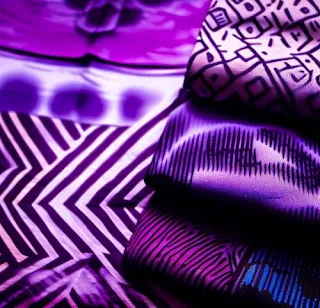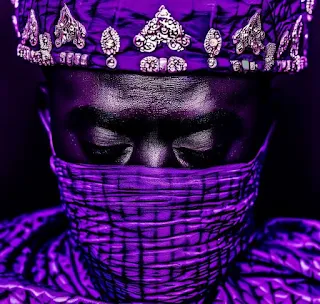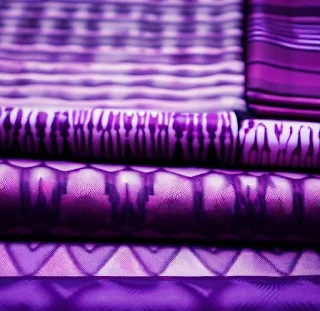Delve into the empire of purple natural dyes! Unravel the powerful history and symbolism of this regal color while engaging in a natural dye project that will enhance your understanding and appreciation of purple.
Colors hold deep cultural and symbolic meanings across the globe, and in Africa purple is the king of colors. From vibrant textiles to traditional ceremonies, colors play a significant role in African culture.
There are countless shades of purple, ranging from deep and dark hues to light and pastel tones. We will delve into the captivating symbolism of the color purple in Africa, exploring its historical context, cultural significance, and the values it represents.
Symbolism of Purple and the African Historical Significance.
Historically associated with nobility, wealth, and spirituality, Purple has been in African culture for centuries. In ancient times, obtaining the color purple was a labor-intensive process involving the extraction of dyes from various sources, such as the Tyrian purple dye from snails.
Due to its rarity and expense, purple became a color associated with power and prestige.
Natural Dye Sources of Purple.Throughout history, African cultures have showcased remarkable resourcefulness and ingenuity in creating purple dyes using natural sources. One fascinating example can be found within the Yoruba people of Nigeria, who harnessed the power of a native plant known as osun to extract purple dyes.
The Yoruba people, renowned for their vibrant textile traditions, utilized the roots of the osun plant to produce rich purple dyes. The process involved carefully harvesting and preparing the roots to extract the dye. The roots were usually boiled or soaked to release the pigments responsible for the purple color.
This extracted dye would then be applied to fabrics, creating stunning purple hues with deep cultural and symbolic significance.
The fact that African communities sought and discovered natural sources to create purple dyes is a testament to their deep understanding of the environment and their ability to harness its resources.
The traditional dyeing techniques these communities employ demonstrate their resourcefulness and innovative spirit. By utilizing what nature provided, they could create vibrant and meaningful colors deeply rooted in their cultural practices.
This historical context adds an enriching layer to the significance of the color purple in African culture. It showcases the close relationship between Africans and their natural surroundings, highlighting their ability to transform plants into beautiful and meaningful expressions of art, identity, and cultural heritage.
Royalty and Purple Power.
Purple holds a special place in African traditions as a symbol of royalty and power. In many African kingdoms and empires, purple garments were exclusively worn by rulers, chiefs, and other dignitaries to signify their high status and authority. The color purple thus represents leadership, nobility, and the divine right to rule.
Africa has a rich history of utilizing plants for natural dyeing, a tradition that predates recorded history. Humans recognized the vibrant staining properties of plants and harnessed them to extract and preserve a captivating array of colors.
The indigenous plants of Africa have played a crucial role in enriching people's lives through the embellishment of animal skins, fabrics, crafts, hair, and even the human body. This ancient practice is not unique to Africa but can be found in various ancient cultures worldwide.
Archaeological findings have unearthed dyed fabrics within the tombs of ancient Egypt, offering a glimpse into the historical significance of natural dyeing. One notable discovery was the Tyrean purple dye, which dates back to 1500 B.C.
This illustrious dye was derived from the glandular secretions of several mollusk species. However, its production was an arduous and costly process, demanding approximately 12,000 mollusks to yield a mere 3.5 ounces of dye. As a result, Tyrean purple became synonymous with royalty, adorning the garments of the elite.
Beyond the grandeur of Tyrean purple, lichens emerged as a resource for a more accessible purple dye known as ochril. Dubbed the poor person's purple, this dye derived from lichens offered an affordable alternative to its opulent counterpart. The resourcefulness of utilizing lichens showcased the ingenuity of ancient cultures in making the most of their surroundings.
Plants in Africa are used as natural sources to produce purple dyes.
The African Indigo plant is widely cultivated in Africa for its deep blue dye. However, modifying the dyeing process can yield shades of purple. Certain species of wild mulberry trees found in Africa produce fruits that can be used to create purple dyes. The fruits are rich in anthocyanin pigments, which impart the purple color.
The leaves and stems of some species of African Mallow contain purple pigments suitable for dyeing. These plants are often found in sub-Saharan Africa. The aromatic herb, African Basil, not only adds flavor to dishes but can also be utilized for dyeing. It produces purple hues when the leaves are used as a dye source.
Certain varieties of African Nightshade, a group of plants native to Africa, possess purple berries or leaves that can be used for dyeing. Traditional knowledge and local practices play a significant role in determining which plants are utilized for dyeing and how the dye extraction process is carried out.
Spiritual and Mystical Significance of Purple.
In African spiritual and mystical beliefs, the color purple is often associated with spirituality, magic, and the supernatural. It is believed to have the ability to connect the physical world with the spiritual realm. Purple is often linked to rituals, ceremonies, and spiritual practices, representing higher consciousness, wisdom, and the divine.
Throughout Africa's diverse landscapes, a tapestry of natural dyes continues to thrive, preserving traditional practices and connecting communities with their ancestral heritage. By embracing these age-old techniques, modern artisans and craftsmen celebrate the beauty of Africa's flora, infusing their creations with a sense of cultural identity and natural splendor.
Cultural Diversity and Purple’s Symbolism.
Africa is a continent rich in cultural diversity, and the symbolism of the color purple can vary across different regions and ethnic groups. For instance, in some African cultures, purple is associated with mourning and death; in others, it represents fertility, abundance, and prosperity. The specific meanings attached to the color purple can be influenced by local customs, folklore, and ancestral traditions.
The knowledge of making purple dyes in Africa was typically held by specific groups within communities with expertise in natural dyeing techniques. These groups often included artisans, dyers, weavers, and individuals with specialized knowledge of plants and their dye properties.
This knowledge was passed down through generations within specific families or guilds in many African cultures. These individuals intimately understood local plants, their harvesting seasons, and the techniques required to extract and produce purple dyes. The knowledge was often transmitted orally and through hands-on apprenticeships, ensuring the preservation and continuity of this traditional craft.
The specific groups or individuals who held this knowledge varied across African regions and cultures. They played a vital role in their communities cultural and economic fabric, providing valuable dyes for textiles, crafts, and artistic expressions. Their expertise and mastery of natural dyeing techniques were highly esteemed and contributed to the vibrant traditions of African textile arts.
Expression of Identity Using Purple Colors.
Colors, including purple, are frequently used in African textiles, clothing, and accessories, enabling individuals and communities to express their identities, affiliations, and cultural heritage. Purple garments, adorned with intricate patterns and designs, showcase the vibrancy and individuality of African cultures, representing a strong sense of belonging and pride.
The color purple can be created by mixing two primary colors: red and blue. You can achieve different shades of purple by combining these two hues in varying proportions. For example, adding more red will produce a warmer, reddish-purple shade, while adding more blue will produce a cooler, bluish-purple hue.
In contemporary Africa, purple remains significant and is often embraced as a symbol of creativity, artistic expression, and cultural innovation. The color is incorporated into modern African fashion, visual arts, and design, blending tradition with modernity and creating a unique fusion of styles.
All shades of purple in African culture carry many meanings.
As we have explored, the color purple in African culture carries multifaceted meanings, symbolizing royalty, power, spirituality, and cultural identity. From its historical association with nobility to its spiritual connotations and contemporary interpretations, purple remains an influential color in the rich tapestry of African traditions.
Embracing the color purple allows individuals to connect with their cultural roots, express their uniqueness, and celebrate the diversity that makes Africa a truly captivating continent.
By understanding the symbolic significance of the color purple in Africa, we gain deeper insights into the traditions, beliefs, and values that shape the continent's diverse cultures and communities.
How to Naturally Dye a White Shirt Purple.
Tips: Choose a white shirt made of natural cotton fibers, as they absorb dyes better than synthetic materials. Wearing rubber gloves is essential to protect your hands from staining. Experiment with different dye sources and dyeing techniques to achieve unique shades of purple.
How to Naturally Dye a White Shirt Purple
Supplies:
White shirt cotton or other natural fibers
Purple natural dye sources such as African Indigo or Wild Mulberry. Buy African Indigo Dye at Etsy, Amazon, Walmart, or Joann Fabrics.
Large pot
Water
Salt
Strainer
Rubber gloves
Stirring utensil
Bucket
Mild detergent
Tools:
Stove
Heat-resistant stove pot
Measuring cup
Pre-wash the white shirt to remove any dirt or chemicals.
Instructions:
Prepare the dye bath by filling a large pot with enough water to submerge the shirt. Follow the instructions specific to your chosen dye source for the water-to-dye ratio.
Add the purple natural dye source to the pot and a recommended amount of salt to enhance the dye's color and adherence.
Place the pot on a stove and bring the water to a simmer. Let it simmer for the duration specified by the dye source instructions, usually around 1-2 hours.
While the dye bath is simmering, wet the white shirt with clean water to ensure even dye absorption.
Put on rubber gloves to protect your hands from staining. Add the spiral design by pinching the shirt's center and twisting it clockwise or counterclockwise until the entire shirt is twisted into a flat spiral shape.
Immerse the wet shirt into the simmering dye bath.
Stir the shirt gently and occasionally to ensure even dye distribution.
Allow the shirt to simmer in the dye bath for the recommended duration, typically around 1-2 hours, or as specified by the dye source.
After achieving the desired color, remove the pot from the heat and carefully remove the dyed shirt. Rinse it with cold water until the water runs clear.
Fill a bucket with clean water and add a small amount of mild detergent. Submerge the rinsed shirt in soapy water and gently agitate to remove any excess dye.
Rinse the shirt again with clean water to remove any remaining soap residue.
Finally, hang the shirt to dry in a well-ventilated area away from direct sunlight.

































